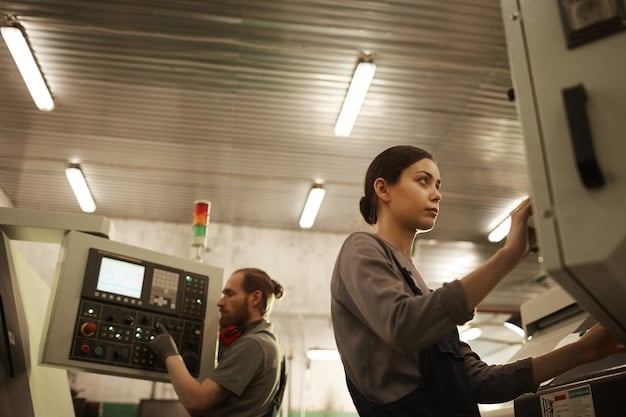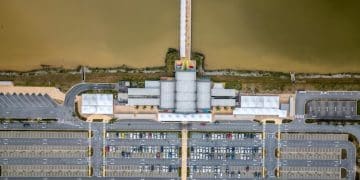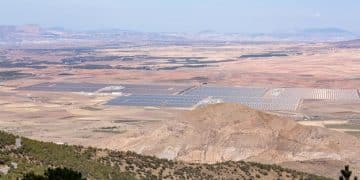Nearshoring to Mexico: A Guide for US Businesses

Navigating the complexities of nearshoring to Mexico involves strategic planning, understanding regulatory frameworks, and leveraging a skilled workforce to achieve significant cost savings and supply chain resilience for US businesses seeking manufacturing solutions.
The landscape of global manufacturing is constantly evolving, prompting US businesses to seek innovative and efficient production solutions. Among the most compelling strategies gaining traction is nearshoring to Mexico: a step-by-step guide for US businesses seeking cost-effective manufacturing solutions.
Understanding the Nearshoring Imperative
As global supply chains face unprecedented disruptions, from geopolitical tensions to pandemic-driven bottlenecks, the traditional model of extensive offshore manufacturing in distant lands has come under scrutiny. Businesses are increasingly recognizing the inherent risks associated with long lead times, rising shipping costs, and precarious logistical networks.
Nearshoring, in this context, emerges as a pragmatic alternative, offering a compelling blend of geographical proximity, cost efficiency, and enhanced supply chain control. Mexico, in particular, stands out as a prime destination for US companies looking to relocate or expand their manufacturing operations closer to home. This strategic shift not only mitigates many of the challenges associated with faraway production but also unlocks a host of benefits that can directly impact a company’s bottom line and competitive advantage.
The evolving global supply chain landscape
The past decade has revealed vulnerabilities in the intricate global supply webs that many multinational corporations relied upon. Events like the Suez Canal blockage, fluctuating commodity prices, and labor shortages in Asia have underscored the need for more resilient and agile supply chain strategies. Nearshoring addresses these fragilities by shortening transportation routes, reducing transit times, and enabling more effective inventory management.
- Reduced lead times: Shorter distances equate to faster delivery of goods and components.
- Enhanced responsiveness: Quicker reaction to market changes and consumer demands.
- Lower freight costs: Significant savings on shipping, especially for bulky or heavy items.
- Improved inventory management: Less capital tied up in goods in transit.
Beyond these immediate benefits, the conversation around sustainability is also driving nearshoring decisions. Reduced shipping distances contribute to a smaller carbon footprint, aligning with corporate environmental responsibilities and consumer expectations for greener practices. This multifaceted appeal positions nearshoring not just as a cost-cutting measure, but as a strategic pivot towards a more sustainable and secure future for manufacturing.
The move to nearshoring is not merely a reactive measure but a proactive strategic decision aimed at building more robust and predictable supply chains. Companies are now looking for stability and consistency, and Mexico’s geographical and economic attributes offer just that, providing a viable pathway to greater operational efficiency and market responsiveness.
Key Advantages of Nearshoring to Mexico
Mexico’s appeal as a nearshoring destination for US businesses is multifaceted, extending far beyond simple geographic proximity. The country offers a compelling combination of economic, logistical, and workforce advantages that collectively contribute to significant cost savings and operational efficiencies. Understanding these core benefits is crucial for any US company considering a manufacturing move south of the border.
At the heart of Mexico’s attractiveness lies its strategic location, directly bordering the United States, which facilitates unparalleled access to the North American market. This geographical advantage translates into tangible benefits, from reduced shipping costs and lead times to easier oversight of manufacturing operations. However, the advantages are not limited to logistics alone; they encompass a broader economic and human capital framework that makes Mexico a highly competitive manufacturing hub.
Cost efficiencies and skilled labor force
One of the primary drivers for nearshoring is the pursuit of cost reduction without compromising quality. Mexico delivers on this front through competitive labor costs, which are often significantly lower than those in the United States, yet still capable of supporting high-quality production. Crucially, Mexico also boasts a growing pool of skilled labor, particularly in sectors like automotive, aerospace, and electronics, thanks to a robust technical education system.
- Competitive labor wages: Lower operational costs due to more affordable workforce.
- Skilled workforce availability: Access to a trained and adaptable labor pool, particularly in technical fields.
- Favorable exchange rates: Potential for additional savings through currency fluctuations.
Beyond direct labor costs, the overall cost of doing business in Mexico can be more attractive, including lower utility costs, competitive rents for industrial real estate, and government incentives designed to attract foreign investment. These economic factors combine to create a compelling financial case for nearshoring operations.
Trade agreements and logistical benefits
The bedrock of Mexico’s trade relationship with the US is the USMCA (United States-Mexico-Canada Agreement), previously NAFTA. This agreement provides a stable and predictable framework for trade, eliminating tariffs on most goods originating from member countries. For US businesses, this means seamless cross-border movement of goods and components, reducing administrative burdens and import duties.
Logistically, Mexico’s extensive infrastructure, including a growing network of highways, railways, and seaports, further enhances its appeal. The ability to truck goods directly into the US market significantly cuts down on transit times and complex shipping procedures commonly associated with Asian supply chains. This streamlined logistics pathway ensures faster delivery to customers and more responsive manufacturing cycles.
The combination of favorable trade agreements and developed logistical networks allows US companies to integrate their Mexican operations tightly into their existing supply chains, minimizing disruptions and maximizing efficiency. This close integration fosters a true partnership, enabling businesses to leverage Mexico’s capabilities as a near-shore extension of their domestic operations, ensuring rapid market access and cost-effective production.

The Step-by-Step Nearshoring Process
Embarking on a nearshoring venture to Mexico requires a methodical approach, from initial assessment to full operational setup. This process, while complex, can be streamlined by understanding each crucial stage and planning accordingly. A clear roadmap ensures smooth transitions, minimizes risks, and maximizes the potential for success in a new operational environment.
The journey begins not with immediate action, but with thorough due diligence and strategic planning. Businesses must first evaluate their own needs and capabilities, then assess Mexico’s suitability against those criteria. This preparatory phase is critical for laying a solid foundation for all subsequent steps, ensuring that the decision to nearshore is well-informed and aligned with long-term business objectives.
Phase 1: preparatory steps and feasibility assessment
Before any physical move or significant investment, US businesses must conduct a comprehensive feasibility study. This involves analyzing various factors, including market demand, supply chain requirements, regulatory compliance, and potential cost savings. A critical component of this phase is determining the most suitable location within Mexico, considering factors like access to skilled labor, infrastructure, and proximity to key transportation hubs.
- Market analysis: Understanding demand for products and services in the North American market.
- Cost-benefit analysis: Detailed projection of potential savings versus initial investment.
- Site selection: Evaluating industrial parks, labor availability, and logistical access in specific regions.
- Legal and regulatory review: Assessing compliance requirements with Mexican laws and USMCA.
Identifying the appropriate legal structure for operations in Mexico is also paramount. Options range from setting up a wholly owned subsidiary to utilizing shelter programs, each with distinct advantages and disadvantages regarding control, liability, and startup speed. Engaging legal and financial experts familiar with Mexican business law is highly recommended at this stage to navigate the complexities effectively.
Phase 2: legal and operational setup
Once the feasibility is confirmed and a location chosen, the next phase involves the formal establishment of the entity and preparation for operations. This includes registering the business, obtaining necessary permits and licenses, and setting up banking and financial systems. Simultaneously, companies must begin the process of recruiting and training their Mexican workforce, adapting to local labor laws and cultural nuances.
The choice between direct setup and utilizing a shelter program becomes particularly pertinent here. A shelter program allows foreign companies to operate in Mexico under the legal umbrella of a Mexican entity, handling administrative, legal, and operational compliance. This significantly reduces the time and complexity of market entry, letting the US company focus on core manufacturing. Without a shelter, the company must manage all aspects directly, a more resource-intensive but potentially more controlling approach.
Phase 3: facility establishment and production launch
This final phase involves the physical setup of the manufacturing facility. This includes acquiring or leasing property, constructing or modifying the plant, procuring machinery and equipment, and establishing utility connections. Ensuring the facility meets all necessary safety and environmental standards, both Mexican and international, is crucial.
Concurrent with facility setup, the focus shifts to robust supply chain integration. This means finding and vetting local suppliers for raw materials and components, or arranging for the efficient cross-border transport of supplies from the US. Quality control systems must be implemented to ensure that products meet specified standards, and staff training on new machinery and processes is vital for a smooth production launch. Continuous optimization and adaptation are key to long-term success, ensuring that the Mexican operation consistently meets performance targets and adapts to evolving market conditions.
Overcoming Challenges and Mitigating Risks
While the benefits of nearshoring to Mexico are substantial, the transition is not without its challenges. US businesses must be prepared to navigate a new operational environment that includes different legal frameworks, cultural norms, and logistical nuances. Proactive risk mitigation and a clear understanding of potential pitfalls are essential for a successful nearshoring venture.
One of the primary areas requiring careful attention is compliance with Mexican labor laws, which differ significantly from those in the US. Understanding union dynamics, severance pay regulations, and social security contributions is vital not only for legal compliance but also for fostering a positive and productive work environment. Ignoring these aspects can lead to costly disputes and operational disruptions.
Navigating legal and regulatory frameworks
Mexican business law, while robust, can be complex for foreign investors. Issues such as import/export regulations, customs procedures, and tax compliance require diligent attention. Engaging local legal counsel specializing in foreign investment is highly advisable to ensure all operations adhere to Mexican laws and international trade agreements like USMCA.
- Permits and licenses: Securing all necessary operational and environmental permits.
- Tax compliance: Understanding corporate taxes, VAT, and specific industry incentives.
- Customs procedures: Efficiently navigating cross-border trade documentation and inspections.
- Intellectual property protection: Registering and safeguarding patents, trademarks, and trade secrets in Mexico.
Beyond general business regulations, industry-specific compliance standards must also be met. For example, the automotive industry has strict local content rules, while electronics manufacturing demands adherence to specific safety and environmental protocols. A thorough due diligence on all applicable regulations is a non-negotiable step.
Cultural integration and workforce management
Successful nearshoring extends beyond legal and financial considerations; it also encompasses effective cultural integration. Understanding and respecting Mexican business culture, communication styles, and work ethics is crucial for building strong relationships with employees, suppliers, and local authorities. Investing in cultural training for expatriate management and fostering an inclusive environment can significantly enhance operational harmony.
Workforce management in Mexico also involves specific considerations like recruitment practices, benefits packages, and performance management. Mexico has a highly skilled and dedicated workforce, but effective management requires an understanding of local labor expectations and the development of clear communication channels. Establishing fair compensation structures and growth opportunities for employees can bolster retention and productivity.
Furthermore, managing expectations regarding local infrastructure, particularly in less developed regions, is important. While major industrial hubs boast excellent facilities, ensuring reliable utilities, transportation links, and support services for a new plant requires careful planning. Companies often invest in backup systems or work closely with local government entities to address potential infrastructure gaps, ensuring uninterrupted operations.
Emerging Trends and Future Outlook
The trajectory of nearshoring to Mexico is not static; it is continually shaped by global economic shifts, technological advancements, and evolving business priorities. As more US companies explore or expand their Mexican manufacturing footprint, several key trends are emerging, indicating a dynamic future for cross-border production relationships.
Perhaps the most significant trend is the increasing sophistication of manufacturing processes being transferred to Mexico. Initially, much of the nearshoring involved labor-intensive assembly. However, there’s a clear shift towards higher-value, more complex manufacturing, including advanced electronics, aerospace components, and specialized automotive parts. This reflects Mexico’s growing technical capabilities and workforce skill sets.
Automation and advanced manufacturing
The adoption of automation, robotics, and advanced manufacturing technologies (Industry 4.0) is becoming increasingly prevalent in Mexican plants serving US companies. This isn’t aimed at replacing labor entirely but at enhancing productivity, precision, and efficiency. Automation helps mitigate rising labor costs over time and allows for the production of highly complex goods with stringent quality requirements. The integration of AI and IoT in manufacturing processes is also on the rise, enabling predictive maintenance, real-time data analysis, and smarter operational decisions.
- Robotics for efficiency: Implementation of robots for repetitive tasks to increase throughput.
- AI and IoT integration: Use of smart technologies for data-driven manufacturing optimization.
- Additive manufacturing (3D printing): Growing application in prototyping and custom parts production.
This technological evolution means that Mexico is not just a destination for low-cost labor but a partner in advanced manufacturing. US companies can leverage these capabilities to produce innovations closer to home, shortening their product development cycles and responding more quickly to market demands, thereby creating a competitive edge.
Sustainability and ESG considerations
Environmental, Social, and Governance (ESG) factors are playing an increasingly critical role in nearshoring decisions. Companies are under growing pressure from consumers, investors, and regulators to demonstrate sustainable practices across their supply chains. Nearshoring to Mexico often provides a more environmentally friendly option due to reduced transportation emissions compared to distant Asian manufacturing. Beyond environmental aspects, social considerations, such as fair labor practices and community engagement, are gaining prominence.
US businesses are now scrutinizing their potential Mexican partners and facilities for adherence to ethical labor standards, worker safety, and community impact. Investing in local communities, providing training and good wages, and ensuring safe working conditions are not just moral imperatives but also contribute to a strong, stable workforce and positive brand reputation. The intersection of economic viability, technological advancement, and ethical practices defines the new frontier of nearshoring to Mexico, positioning it as a strategic imperative for global competitiveness.
Financing Your Nearshoring Venture
Securing adequate financing is a critical component of any successful nearshoring strategy. The initial capital investment for setting up operations in Mexico, including factory construction or leasing, machinery procurement, and operational startup costs, can be substantial. US businesses need to explore a range of financing options to ensure their nearshoring venture is robustly supported from the outset.
The financial landscape for foreign investment in Mexico is diverse, offering various avenues from traditional bank loans to specialized government programs and private equity. Understanding these options and identifying the one that best aligns with a company’s financial health and strategic goals is paramount. Strategic partnerships with financial institutions familiar with cross-border transactions can provide crucial guidance and facilitate smoother access to capital.
Traditional and specialized financing options
For many businesses, traditional bank loans remain a primary financing source. Major international banks with a presence in both the US and Mexico can offer cross-border financing solutions, simplifying the process. These loans can be secured or unsecured, depending on the company’s creditworthiness and assets. It’s also worth exploring local Mexican banks, which might offer competitive terms if a company establishes a strong local financial presence.
- Commercial bank loans: Accessing capital from established financial institutions.
- Export-Import Bank (EXIM) financing: US government agency support for American exporters, including loan guarantees.
- Mexican development banks: Institutions like Bancomext or Nafin offering loans/guarantees for foreign direct investment.
- Private equity and venture capital: Investment from specialized funds for high-growth potential projects.
Beyond conventional loans, companies can consider asset-backed financing, where machinery or real estate in Mexico serves as collateral. Equipment leasing is another flexible option that avoids large upfront capital outlays for machinery, preserving liquidity for other operational needs. For larger, more strategic projects, development banks in both the US and Mexico offer specialized programs and loan guarantees designed to promote foreign direct investment and job creation.
Government incentives and foreign direct investment (FDI) programs
Both the US and Mexican governments offer various incentives aimed at facilitating foreign direct investment and fostering economic development. In Mexico, these incentives can range from tax breaks and duty exemptions to infrastructure development support. Special economic zones, known as maquiladoras, offer particularly attractive benefits, allowing for duty-free import of raw materials and components for goods that are then exported.
Understanding the eligibility criteria and application processes for these incentives is key. Companies should consult with financial advisors and legal experts specializing in international investment to identify and apply for all applicable programs. Leveraging these incentives can significantly reduce the initial financial burden and enhance the long-term profitability of nearshoring operations, making the venture even more appealing.
Additionally, some US states and federal agencies offer programs to support American companies expanding internationally, including those investing in Mexico. These might include trade advisory services, market intelligence, and sometimes even financial assistance for feasibility studies or export development. The key to successful financing lies in a proactive and diversified approach, exploring all possible avenues to secure the capital needed for a robust and sustained nearshoring presence in Mexico.
Building Strong Mexican Partnerships
The success of any nearshoring initiative in Mexico is profoundly influenced by the quality of local partnerships. From legal counsel and logistical providers to suppliers and government agencies, cultivating robust relationships is paramount for navigating the business landscape, ensuring compliance, and fostering operational efficiency. These partnerships are not merely transactional; they are foundational to sustainable growth and problem-solving in a new environment.
Engaging with local experts from the outset provides invaluable insights into Mexican business practices, cultural norms, and regulatory intricacies. This collaboration can help US businesses avoid common pitfalls, accelerate market entry, and ultimately build a more resilient and integrated supply chain. The importance of trust and mutual understanding in these relationships cannot be overstated, as they often underpin effective problem-solving and long-term success.
Selecting reliable local partners
Identifying and vetting reliable local partners is a critical early step. This includes legal firms specializing in Mexican corporate law, financial advisors familiar with cross-border taxation, and customs brokers who can navigate import/export regulations. Choosing a reputable shelter company, if opting for that model, is also crucial, as they will manage many administrative and compliance aspects.
- Legal counsel: Expertise in business formation, labor law, and intellectual property.
- Customs brokers: Facilitating smooth cross-border movement of goods.
- Logistics providers: Reliable transportation and warehousing solutions within Mexico and to the US.
- Shelter program providers: Experienced entities to manage administrative burdens.
Beyond professional services, identifying reliable local suppliers for components, raw materials, or MRO (maintenance, repair, and operations) is essential. A robust local supply network can further enhance cost savings and reduce reliance on international shipments. Due diligence, including site visits and reference checks, is vital when selecting these partners to ensure they meet quality, delivery, and ethical standards.
Engaging with government and community
Building positive relationships with local and federal government entities in Mexico can significantly ease the establishment and operation of a manufacturing plant. This involves understanding permitting processes, adhering to environmental regulations, and potentially engaging in discussions about local infrastructure improvements or workforce development initiatives. Proactive communication and transparency can foster goodwill and facilitate smoother interactions.
Equally important is engaging with the local community where the facility is located. This can involve participating in community development programs, supporting local education initiatives, or simply ensuring responsible corporate citizenship. A positive community relationship can enhance local hiring, improve employee morale, and build a strong reputation, contributing to the long-term stability and success of the nearshoring operation. These interconnected partnerships—legal, logistical, governmental, and community—form the bedrock upon which a thriving Mexican manufacturing operation can be built.

| Key Aspect | Brief Description |
|---|---|
| ✈️ Strategic Location | Proximity to the US reduces shipping costs and lead times. |
| 💰 Cost-Effectiveness | Competitive labor costs and favorable operational expenses. |
| ⚖️ Trade Agreements | USMCA ensures tariff-free trade and stable regulatory framework. |
| 🎯 Skilled Workforce | Access to a growing pool of trained and adaptable talent. |
Frequently Asked Questions about Nearshoring to Mexico
▼
The main advantages include geographical proximity to the US, significant cost savings on labor and logistics, favorable trade agreements like USMCA, and access to a skilled manufacturing workforce. These factors combine to create a more resilient and responsive supply chain.
▼
The USMCA (United States-Mexico-Canada Agreement) is crucial. It provides a stable framework for trade, eliminates tariffs on most goods, and sets rules of origin that benefit North American production. This simplifies cross-border logistics and enhances cost predictability for US businesses in Mexico.
▼
Initial steps involve a thorough feasibility assessment, including market analysis, cost-benefit projections, and site selection within Mexico. It’s also vital to consult with legal and financial experts familiar with Mexican regulations to understand compliance and potential incentives available for foreign investment.
▼
Yes, challenges include navigating Mexican legal and labor laws, cultural differences in workforce management, and logistics complexities specific to certain regions. Proactive planning, strong local partnerships, and adapting to the local business environment are key to overcoming these hurdles successfully.
▼
Ensuring robust quality control involves implementing international production standards, strict supplier vetting, and continuous monitoring. Many US companies embed their own quality assurance teams or use third-party auditing services to maintain high product quality, coupled with local workforce training in quality protocols.
Conclusion
Ultimately, the decision for US businesses to engage in nearshoring to Mexico is a strategic one, increasingly driven by the imperative for resilient, cost-effective, and geographically proximate manufacturing solutions. By carefully navigating the step-by-step process, from initial feasibility studies to building strong local partnerships, companies can unlock significant advantages. Mexico’s unique blend of a skilled workforce, favorable trade agreements, and logistical proximity offers a compelling alternative to distant global supply chains, presenting a clear path toward enhanced operational efficiency and sustainable growth in the evolving landscape of international manufacturing.





